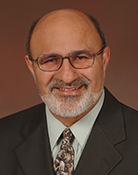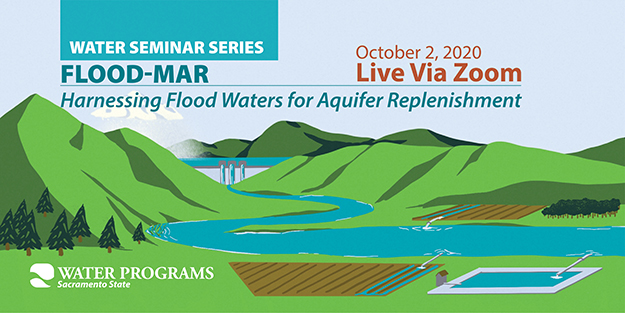Flood-MAR: Harnessing Flood Waters for Aquifer Replenishment
Water Seminar Moves to New Format
In response to health concerns about COVID-19 (the novel coronavirus), our Water Seminars will now be held via Zoom. Please check back soon for details on our upcoming November 2020 seminar.
Topic: Flood-MAR: Harnessing Flood Waters for Aquifer Replenishment
Speaker: Kamyar Guivetchi, California Department of Water Resources
When: (Updated) Friday, October 2, 12 pm to 1pm
Where: Virtual (via Zoom)—Link to virtual seminar to be sent upon RSVP
The recording of the webinar is available here.
California is known for its variable climate with perennial oscillations between drought and flood events. Climate change is exacerbating this variability, and water managers are exploring ways to capitalize on the extremes by redirecting flood waters into parched aquifers. This strategy is called Flood Managed Aquifer Recharge, or Flood-MAR, and it is part of California's effort to modernize its green and gray infrastructure and to co-manage the state's entire water portfolio for multiple public and private benefits.
Competing water demands across all sectors, limited and variable water supplies, and a complicated regulatory framework make it challenging to plan and manage water resources in California. Water users, planners, managers, landowners, and policy-makers must collectively plan, manage, and adapt California's water systems in a proactive ways to ensure the systems are resilient to changing conditions and able to adapt nimbly and dynamically to stressors. Only proactive strategic planning and adaptation—at state, federal, regional, and local levels—can ensure a sustainable future for California.
Flood-MAR is an emerging water management strategy that epitomizes integrated watershed management and is inherently multi-benefit. It provides flood risk reduction, drought preparedness, aquifer replenishment, ecosystem enhancement, and other potential benefits. It is also a promising climate change adaptation strategy that takes an integrated approach to address the consequences of extreme events, including flashier, intense flood flows and longer, deeper droughts.
To implement Flood-MAR in a big way, California and its regions must:
- Recognize aquifers as natural infrastructure providing ecosystem services, and replenishment of aquifers as a public benefit
- Engage in integrated and multi-disciplinary watershed management
- Implement multi-benefit projects
- Align its water sectors, institutions, and regulations
- Harness innovation, research, and data
- Commit sufficient and stable funding
Large-scale implementation of Flood-MAR requires a robust public-private partnership, landowner participation, and the use of agricultural lands and working landscapes as effective and essential pathways for groundwater recharge and aquifer replenishment.
The Department of Water Resources (DWR) is seeking partnerships to expand Flood-MAR studies and project implementation throughout the state. Scaling up Flood-MAR will require extensive collaboration, agency alignment, and sector co-management. For more information and updates on Flood-MAR, visit the DWR program page.
About the Speaker
 Kamyar Guivetchi was appointed a division manager at the California Department of Water Resources (DWR) in 2008. During his 41 years with DWR, Kamyar worked on technical studies and planning projects with Statewide Integrated Water Management, North-Central Region Office, Division of Planning, Bay-Delta Office, and Division of Environmental Services managing the Suisun Marsh Program.
Kamyar Guivetchi was appointed a division manager at the California Department of Water Resources (DWR) in 2008. During his 41 years with DWR, Kamyar worked on technical studies and planning projects with Statewide Integrated Water Management, North-Central Region Office, Division of Planning, Bay-Delta Office, and Division of Environmental Services managing the Suisun Marsh Program.
For the past 19 years, Kamyar managed staff work and coordinated the collaboration of numerous government agencies, Native American Tribes, stakeholders, and the public to prepare the California Water Plan Updates in 2005, 2009, 2013, and 2018. He chairs the 30-member State Agency Steering Committee and is the State Co-chair of the California Biodiversity Council's Executive Committee.
Kamyar has a Bachelor of Science in Civil Engineering; completed post graduate work in Environmental Engineering at the University of California, Davis; and is a California-registered Civil Engineer.

